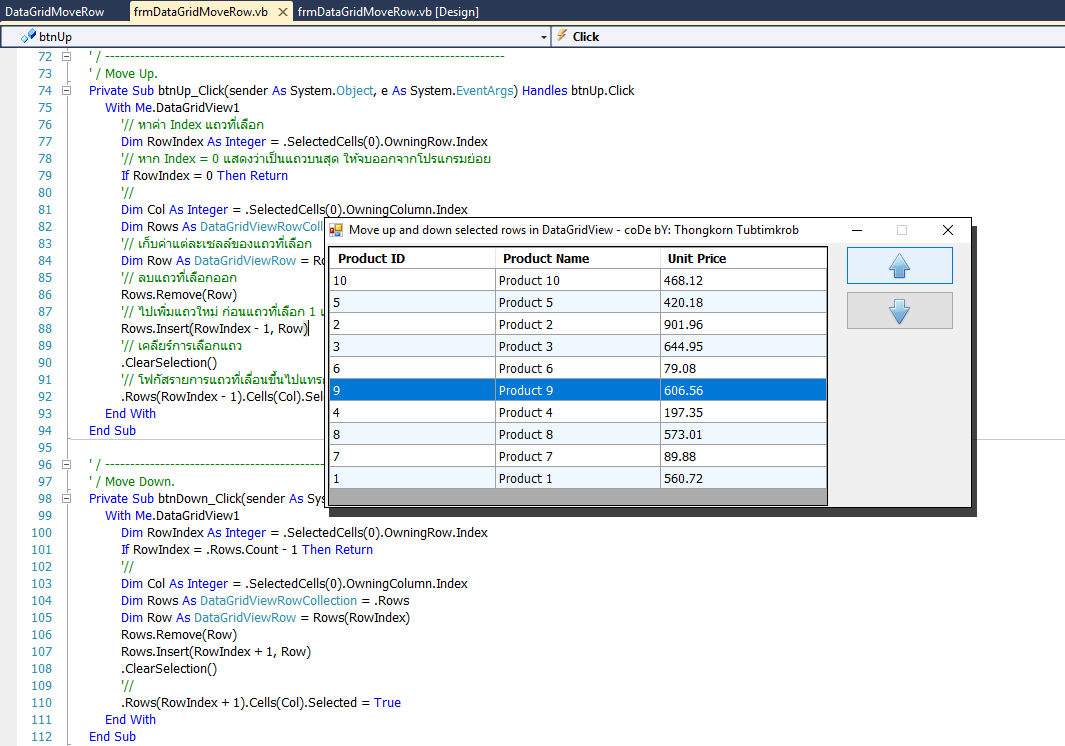|
|

หลักการคิดสำหรับการเคลื่อนย้ายแถวขึ้นบน : เลือกแถวที่ต้องการ ตรวจสอบว่าแถวนั้นต้องมีค่า Index มากกว่า 0 (แถวแรก Index = 0) จากนั้นคัดลอกรายการแถวนั้นๆเอาไว้ก่อน เพื่อเก็บค่าไว้ในตัวแปรแบบแถวของตารางกริด (Dim Row As DataGridViewRow) แล้วทำการลบแถวที่เลือกออกไป สุดท้ายให้แทรก (Insert) แถวที่คัดลอกเอาไว้ นำไปวางไว้หน้าแถวที่เลือกลบออกด้วย 1 ก็จะทำให้เสมือนเกิดการเคลื่อนย้ายตำแหน่งแถวได้นั่นเอง ... สำหรับการเคลื่อนย้ายแถวลง ก็คิดเหมือนกัน แต่คำนวณหาจำนวนแถวสูงสุด
มาดูโค้ดกันเถอะ ...
- Public Class frmDataGridMoveRow
- Private Sub frmDataGridMoveRow_Load(sender As System.Object, e As System.EventArgs) Handles MyBase.Load
- Call InitDataGrid()
- End Sub
- ' / --------------------------------------------------------------------------------
- ' / Initialized DataGridView and put the sample data.
- Private Sub InitDataGrid()
- '// Initialize DataGridView Control
- With DataGridView1
- .RowHeadersVisible = False
- .AllowUserToAddRows = False
- .AllowUserToDeleteRows = False
- .AllowUserToResizeRows = False
- .MultiSelect = False
- .SelectionMode = DataGridViewSelectionMode.FullRowSelect
- .ReadOnly = True
- .Font = New Font("Tahoma", 9)
- ' Autosize Column
- .AutoSizeColumnsMode = DataGridViewAutoSizeColumnsMode.Fill
- .AutoResizeColumns()
- '// Even-Odd Color
- .AlternatingRowsDefaultCellStyle.BackColor = Color.AliceBlue
- ' Adjust Header Styles
- With .ColumnHeadersDefaultCellStyle
- .BackColor = Color.Navy
- .ForeColor = Color.Black ' Color.White
- .Font = New Font("Tahoma", 9, FontStyle.Bold)
- End With
- End With
- '// Declare columns type.
- Dim Column1 As New DataGridViewTextBoxColumn()
- Dim Column2 As New DataGridViewTextBoxColumn()
- Dim Column3 As New DataGridViewTextBoxColumn()
- '// Add new Columns
- DataGridView1.Columns.AddRange(New DataGridViewColumn() { _
- Column1, Column2, Column3 _
- })
- With DataGridView1
- .Columns(0).Name = "Product ID"
- .Columns(1).Name = "Product Name"
- .Columns(2).Name = "Unit Price"
- End With
- '// SAMPLE DATA
- Dim RandomClass As New Random()
- For iCount As Byte = 1 To 10
- Dim row = New String() { _
- iCount, "Product " & iCount, Format(RandomClass.Next(999) + RandomClass.NextDouble(), "0.00")}
- DataGridView1.Rows.Add(row)
- Next
- End Sub
- ' / --------------------------------------------------------------------------------
- ' / Move Up.
- Private Sub btnUp_Click(sender As System.Object, e As System.EventArgs) Handles btnUp.Click
- With Me.DataGridView1
- '// หาค่า Index แถวที่เลือก
- Dim RowIndex As Integer = .SelectedCells(0).OwningRow.Index
- '// หาก Index = 0 แสดงว่าเป็นแถวบนสุด ให้จบออกจากโปรแกรมย่อย
- If RowIndex = 0 Then Return
- '//
- Dim Col As Integer = .SelectedCells(0).OwningColumn.Index
- Dim Rows As DataGridViewRowCollection = .Rows
- '// เก็บค่าแต่ละเซลล์ของแถวที่เลือก
- Dim Row As DataGridViewRow = Rows(RowIndex)
- '// ลบแถวที่เลือกออก
- Rows.Remove(Row)
- '// ไปเพิ่มแถวใหม่ ก่อนแถวที่เลือก 1 แถว (ก็เลยเสมือนมันเคลื่อนย้ายแถวได้)
- Rows.Insert(RowIndex - 1, Row)
- '// เคลียร์การเลือกแถว
- .ClearSelection()
- '// โฟกัสรายการแถวที่เลื่อนขึ้นไปแทรก
- .Rows(RowIndex - 1).Cells(Col).Selected = True
- End With
- End Sub
- ' / --------------------------------------------------------------------------------
- ' / Move Down.
- Private Sub btnDown_Click(sender As System.Object, e As System.EventArgs) Handles btnDown.Click
- With Me.DataGridView1
- Dim RowIndex As Integer = .SelectedCells(0).OwningRow.Index
- If RowIndex = .Rows.Count - 1 Then Return
- '//
- Dim Col As Integer = .SelectedCells(0).OwningColumn.Index
- Dim Rows As DataGridViewRowCollection = .Rows
- Dim Row As DataGridViewRow = Rows(RowIndex)
- Rows.Remove(Row)
- Rows.Insert(RowIndex + 1, Row)
- .ClearSelection()
- '//
- .Rows(RowIndex + 1).Cells(Col).Selected = True
- End With
- End Sub
- End Class
ดาวน์โหลดโค้ดต้นฉบับ VB.NET (2010) ได้ที่นี่ ...
|
ขออภัย! โพสต์นี้มีไฟล์แนบหรือรูปภาพที่ไม่ได้รับอนุญาตให้คุณเข้าถึง
คุณจำเป็นต้อง ลงชื่อเข้าใช้ เพื่อดาวน์โหลดหรือดูไฟล์แนบนี้ คุณยังไม่มีบัญชีใช่ไหม? ลงทะเบียน
x
|
